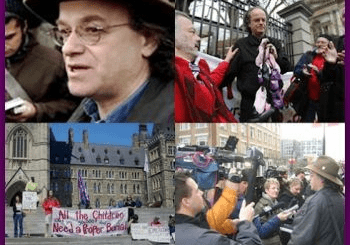Still Think a Pedophocracy Isn’t Running The World-Vatican 80% Sodomite to Bring in the New Age of Luciferianism-Pope Holding & Sitting With Luciferian Cross (Bent & Upside Down)
New book claims gay subculture flourishes at Vatican
- Christopher WhiteFeb 16, 2019NATIONAL CORRESPONDENT

Pope Francis leads an ordinary public consistory for the conclusion of sainthood causes at the Vatican. (Credit: CNS.)
ROME – A new book, whose release is timed to coincide with the start of Pope Francis’s major summit on sex abuse on February 21, contains sweeping, although unverified, claims that 80 percent of the Vatican clergy are gay.
In the Closet of the Vatican: Power, Homosexuality, Hypocrisy by French journalist Frédéric Martel will be released in 8 languages in 20 countries and is the product of 4 years of research and interviews with over 1,500 individuals in 30 countries, including 41 cardinals, 52 bishops, and 45 apostolic nuncios.
Ahead of its release, Crux reviewed portions of the work, which, among its most scandalous claims, alleges Colombian Cardinal Alfonso López Trujillo, Pope John Paul II’s point man on marriage and family, had a “double life” with male prostitutes and affairs, alleges the two deceased “dubia” cardinals were gay, and that “this best kept secret of the Vatican is no secret to Pope Francis,” and it is the motivation for the pontiff regularly speaking out on hypocrisy.
While Martel, who is openly gay, fails to document what percentage of Vatican clergy are actively gay, and at times makes the distinction between those whom he believes are in-touch with their homosexuality but do not act on their orientation and those who do so, he maintains that “the world I am discovering, with its 50 shades of gay, is beyond comprehension,” and ultimately defines many of the power struggles inside the Church.
Martel begins the nearly 600-page book with the expression “he’s of the parish,” a phrase he claims is used frequently inside the Vatican to identify members of the clergy who are known to be homosexual.
As the text unfolds, Martel establishes what he terms as fourteen “rules of the closet,” which are broad principles for understanding both the operations and tensions within the Vatican over this issue.
Perhaps the most salient reason for the timing of the book’s release is the rule that “behind the majority of cases of sexual abuse, there are priests and bishops who have protected the aggressors because of their own homosexuality and out of fear that it might be revealed in the event of a scandal.”
“The culture of secrecy that was needed to maintain silence about the high prevalence of homosexuality in the Church has allowed sexual abuse to be hidden and prelates to act,” he continues.
While Martel steers clear of the argument that homosexuality within the priesthood is a driving force for sexual abuse, he argues that the culture of secrecy is what allows it to flourish, along with its cover-up, even within the highest ranks of power.
Pope Benedict XVI’s abdication from the papacy is 2013, Martel argues, was largely motivated by his inability to navigate and control this environment. While he details the various factors which he terms Benedict’s “via crucis,” including his own declining health, Martel says ten out of the fourteen reasons for the retired pope’s resignation were “linked to the homosexual question.”
Although he doesn’t offer evidential support, besides certain rumors and his affinity for liturgical dress, Martel claims that Benedict “liked to flirt,” and throughout the book implies that the majority of the popes of the last century were at least homosexually inclined.
His most stinging critiques are focused on dominant figures in Pope John Paul II’s more than two decades-long papacy, including his right-hand men, polish prelate Cardinal Stanisław Dziwisz and Cardinal Angelo Sodano, along with Father Marcial Maciel, the disgraced Mexican priest who founded the Legion of Christ and was later found guilty of facilitating a culture of abuse within the movement, in addition to having numerous affairs with both men and women.
Martel’s account of the John Paul era is a blend of both sexual and financial corruption, often entangled.
“The suitcases containing money were a gift only made possible under the pontificate of John Paul II,” he writes, describing Dziwisz and Sodano’s long tradition of bringing in “dirty money for good causes” that were used to promote anti-Communist and pro-marriage and family initiatives.
“Many cardinals around John Paul II in fact led a double life,” he concludes, describing his inner circle as “a ring of lust.”
Trujillo is a major focus of Martel’s exposé, wherein he recounts his four visits to Colombia to interview numerous individuals, including members of the “assembly line of prostitutes” allegedly serviced by the South American cardinal.
“If there is one pathetic character in this book, it is Lopez Trujillo,” Martel writes of the former president of the Pontifical Council for the Family, who reportedly kept an apartment in Medellin near the cathedral for his affairs.
He also recounts interviews with several high-ranking Church officials who either confirmed those accounts or implicity acknowleged them, with Archbishop Claudio Maria Celli, the former head of Vatican communications, telling him, Trujillo was “not a saint by any means.”
In Rome, Martel interviewed numerous male prostitutes that are stationed near Termini, the city’s main train station, who describe priests and members of the hierarchy as being among their most regular, and often most demanding, clients.
During his regularly monthly visits to Rome, where at one point Martel lived inside a Vatican apartment, he also spoke to eleven Swiss Guards, who told Martel they felt as if they were viewed as “fresh meat” by members of the Roman Curia.
“They want to impose celibacy on us and refuse to marry because they want to keep us for themselves,” one told him.
In addition, Martel interviewed members of one of Italy’s main law enforcement branches, the carabinieri, who described numerous cases involving male escorts and Vatican officials relying on their diplomatic immunity for protection.
Many of the recent controversies, both over doctrine and administration, during the Francis pontificate, Martel alleges, are motivated by competing factions of homosexuals within the Church with competing agendas.
He alleges that now deceased Italian Cardinal Carlo Caffarra and German Cardinal Joachim Meisner, two of the four cardinals who famously issued a “dubia” to Pope Francis related to questions over communion for divorced and remarried Catholics, were both homosexually inclined, along with American Cardinal Raymond Burke, another dubia cardinal, with whom Martel spent time in his apartment but whose interview was eventually cancelled due to a scheduling conflict, whom he describes as “unstraight.”
Speaking about the recent letter published by former papal ambassador to the United States, Archbishop Carlo Maria Viganò, which along with alleging that Pope Francis knew of former Cardinal Theodore McCarrick’s history of misconduct, decries the underground “homosexual collusion” of clerics inside the Vatican, Martel says that Viganò fails to acknowledge that many of his perceived allies are, in fact, homosexuals themselves.
“Francis today is the object of a violent campaign, precisely because of his supposed liberalism on questions of sexual morality, by conservative cardinals who are very homophobic – and many of them, secretly homosexual,” writes Martel.
Among his other “rules of the closet” is that the clerics who are perceived to be most “pro-gay” are likely heterosexual and that within the Vatican, heterosexuality is “the exception.”
Martel claims French Cardinal Jean-Louis Pierre Tauran, who died in 2018, served as a close source during his research. The author described Tauran as being “in touch” with his homosexuality. Among his other notable interviews is American Cardinal James Francis Stafford, who the author describes with particular affinity and recounts him as being scandalized by Martel’s findings.
In sum, for Martel, Francis’s own words that “behind rigidity there is always something hidden, in many cases a double life,” serve as a truism for his account.
While the printed book does have an index, at the time of the book’s publication, another 300 pages of additional notes will also be released online.
[Editor’s Note: The claim that 80 percent of the Vatican clergy are gay does not come directly from Martel, but from a priest interviewed in the book.]














